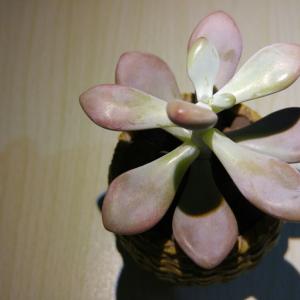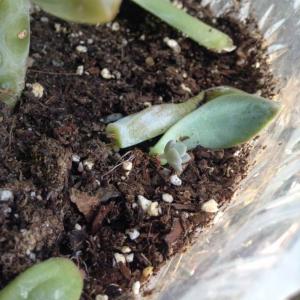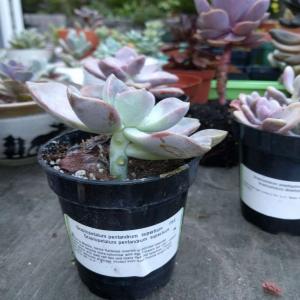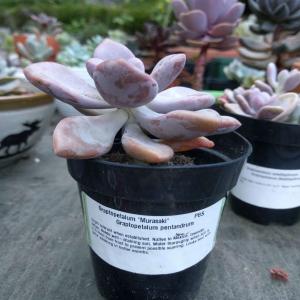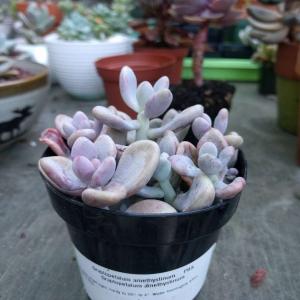文章
Dummer. ゛☀
2017年08月23日

Succulents are a diverse form of plants that includes cacti and other moisture-storing specimens. Graptopetalum ghost plant develops a rosette shape on stems which may trail or hang. As with most plants in this group, water needs are little and exposure is important. Ghost flower plant care hinges on providing a natural environment that mimics the succulent’s native habitat. Tips on how to grow a Graptopetalum will ensure your ghost plant is healthy and enjoyable for many years.

Graptopetalum Ghost Plant Information
Thick, fleshy leaves and stems characterize most succulent plants. Ghost plants (Graptopetalum paraguayense) have thick leaves that hold excess moisture so the plant can withstand periods without rain. The silvery gray to bluish green foliage has a pinkish tinge to the edges of the leaves when they are young. Layers of leaves form the rosette, which range in size from less than an inch across to several inches wide. The plant is related to and resembles Echeveria, which is a common and fairly hardy succulent plant often used in container gardens.
These plants have color changing abilities. Full sun is the best location for them, but growing succulent ghost plants in partial shade produces the bluish-gray tones. Full sun plants tend to be yellowish-pink, pearlescent and slightly translucent. Those in punishing heat turn gray with pink overtones. Full ghost plant information must include the detail that the plant grows from the center of the rosette. This gives mature succulents a rangy appearance, which is easy fix by pinching back. The plant flowers occasionally in spring to summer with airy little yellow blooms.

How to Grow a Graptopetalum
The stems on this plant are fairly brittle and detach easily. This is because in its habitat, Graptopetalum ghost plant reproduces vegetatively. Any rosette that breaks off has the potential to root and start a new plant. Even a leaf that drops off will root below the parent plant and produce a new rosette quickly. The new plant feeds off the leaf until it shrivels up and falls off. By then the new little ghost plant has rooted and sprouted new leaves. Growing succulent ghost plants is ridiculously easy and a great confidence booster for the novice gardener. USDA zones 7b and up are suitable for growing succulent ghost plants. The rules for ghost flower plant care are similar to those for most succulents. Container-bound plants thrive in a mixture of peat, sand or other grit, topsoil and a little bit of compost. Full sun is the best situation but they will also grow in partial sun with slightly rangy results. Because the stems are so fragile, it is best to pick the best location for ghost plant and then don’t move it. Ghost plants need excellent drainage and moderate water. You can tell when to water by sticking your finger in the soil. If it is dry several inches down or the fleshy leaves are looking shriveled, you should water. Overwatering is a cause of root rots and the plant can get several pest infestations. Fertilize it in early spring and provide water only monthly in winter.

Graptopetalum Ghost Plant Information
Thick, fleshy leaves and stems characterize most succulent plants. Ghost plants (Graptopetalum paraguayense) have thick leaves that hold excess moisture so the plant can withstand periods without rain. The silvery gray to bluish green foliage has a pinkish tinge to the edges of the leaves when they are young. Layers of leaves form the rosette, which range in size from less than an inch across to several inches wide. The plant is related to and resembles Echeveria, which is a common and fairly hardy succulent plant often used in container gardens.
These plants have color changing abilities. Full sun is the best location for them, but growing succulent ghost plants in partial shade produces the bluish-gray tones. Full sun plants tend to be yellowish-pink, pearlescent and slightly translucent. Those in punishing heat turn gray with pink overtones. Full ghost plant information must include the detail that the plant grows from the center of the rosette. This gives mature succulents a rangy appearance, which is easy fix by pinching back. The plant flowers occasionally in spring to summer with airy little yellow blooms.

How to Grow a Graptopetalum
The stems on this plant are fairly brittle and detach easily. This is because in its habitat, Graptopetalum ghost plant reproduces vegetatively. Any rosette that breaks off has the potential to root and start a new plant. Even a leaf that drops off will root below the parent plant and produce a new rosette quickly. The new plant feeds off the leaf until it shrivels up and falls off. By then the new little ghost plant has rooted and sprouted new leaves. Growing succulent ghost plants is ridiculously easy and a great confidence booster for the novice gardener. USDA zones 7b and up are suitable for growing succulent ghost plants. The rules for ghost flower plant care are similar to those for most succulents. Container-bound plants thrive in a mixture of peat, sand or other grit, topsoil and a little bit of compost. Full sun is the best situation but they will also grow in partial sun with slightly rangy results. Because the stems are so fragile, it is best to pick the best location for ghost plant and then don’t move it. Ghost plants need excellent drainage and moderate water. You can tell when to water by sticking your finger in the soil. If it is dry several inches down or the fleshy leaves are looking shriveled, you should water. Overwatering is a cause of root rots and the plant can get several pest infestations. Fertilize it in early spring and provide water only monthly in winter.
2
4
Ueca
2017年08月22日

An arrangement incorporating Echeveria, Sedum, Crassula, Graptopetalum, and Kalanchoe.


1
0
成长记
SucculentLover021815
2017年08月11日

I new added a "Ghosty 'Graptopetalum Paraguayense'" in my "garden"


0
0
求助
Ueca
2017年08月04日

What are these succulents? 3 looks like Graptopetalum but I've never seen them so red.

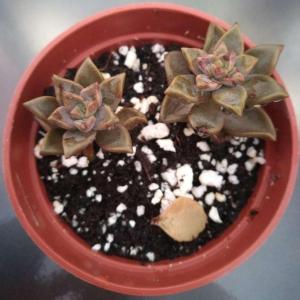
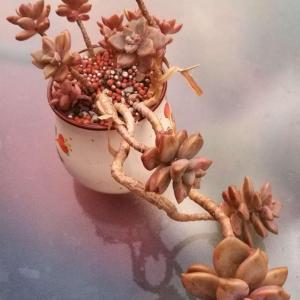
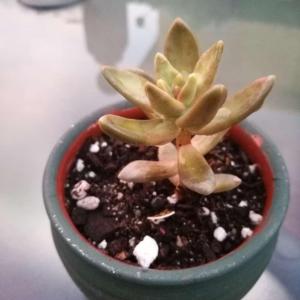

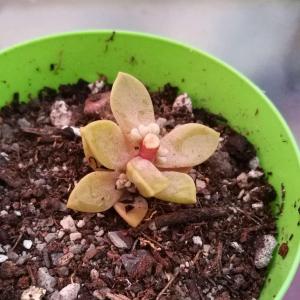






1
0
Ueca:I suspect 4 is Sedum adolphii, also in poor health.
Ueca:I suspect 1 is Echeveria agavoides, in poor health.
文章
玲儿
2017年07月09日

グラプトペタルムの基本情報
学名:Graptopetalum
その他の名前:グラプトペタラム
科名 / 属名:ベンケイソウ科 / グラプトペタルム属
特徴
グラプトペタルムは、中米・メキシコ原産の多肉植物です。多くは肉厚の葉をもち、葉の表面にうっすらと白い粉を帯びています。多くの種類は茎立ちをし、ロゼット状に葉を展開します。厳しい環境下でも生育する「朧月(おぼろづき)」は、古くから庭や石垣に植えられてきました。長く垂れ下がり、群生した姿を目にします。
日照を好み、比較的暑さ寒さには強いです。葉を凍らせなければ、戸外での管理が可能です。春先にはオレンジ色や黄色の花を咲かせます。底の浅い鉢での栽培もでき、何年も植え替えをせずに管理すると盆栽風な姿も楽しめます。比較的育てやすく、葉ざしも容易にできるため、初心者にも育てやすい植物といえるでしょう。

グラプトペタルムの種類(原種、品種)
主な原種、園芸品種、仲間
姫秋麗(ひめしゅうれい)
Graptopetalum mendozae
小型で群生しやすい種類。春から秋まで戸外での栽培が可能だが、夏の蒸れに少し弱いので注意する。肥料、水を多く与えると葉が落ちやすくなるので、少なめに与え、株を締めて栽培する。葉ざしが容易。

グラプトペタルム・アメチスチヌム
Graptopetalum amethystinam
丸々とした肉厚の葉が特徴。蒸れに弱いため、夏場は遮光下で水やりを少なめにして栽培するとよい。葉ざしが容易にできる。
グラプトペタルム・ペンタンドルム
Graptopetalum pentandrum
葉の詰まったロゼット状で、大きくなるにつれて幹立ちしてくる。葉の表面にうっすらと白い粉があり、生育すると最大15cmになる。非常に美しい種類で、夏の暑さや冬の寒さにも強く、丈夫で育てやすい人気種。

朧月(おぼろづき)
Graptopetalum paraguayense
暑さ寒さに強く、葉が凍らなければ戸外での栽培が可能。健強でよくふえ、葉ざしも容易。幹立ちしたら、今年伸びた新しい茎を葉を3枚程度残してカットして、株姿を整えるとよい。カットするハサミやナイフは消毒してから用いる。

学名:Graptopetalum
その他の名前:グラプトペタラム
科名 / 属名:ベンケイソウ科 / グラプトペタルム属
特徴
グラプトペタルムは、中米・メキシコ原産の多肉植物です。多くは肉厚の葉をもち、葉の表面にうっすらと白い粉を帯びています。多くの種類は茎立ちをし、ロゼット状に葉を展開します。厳しい環境下でも生育する「朧月(おぼろづき)」は、古くから庭や石垣に植えられてきました。長く垂れ下がり、群生した姿を目にします。
日照を好み、比較的暑さ寒さには強いです。葉を凍らせなければ、戸外での管理が可能です。春先にはオレンジ色や黄色の花を咲かせます。底の浅い鉢での栽培もでき、何年も植え替えをせずに管理すると盆栽風な姿も楽しめます。比較的育てやすく、葉ざしも容易にできるため、初心者にも育てやすい植物といえるでしょう。

グラプトペタルムの種類(原種、品種)
主な原種、園芸品種、仲間
姫秋麗(ひめしゅうれい)
Graptopetalum mendozae
小型で群生しやすい種類。春から秋まで戸外での栽培が可能だが、夏の蒸れに少し弱いので注意する。肥料、水を多く与えると葉が落ちやすくなるので、少なめに与え、株を締めて栽培する。葉ざしが容易。

グラプトペタルム・アメチスチヌム
Graptopetalum amethystinam
丸々とした肉厚の葉が特徴。蒸れに弱いため、夏場は遮光下で水やりを少なめにして栽培するとよい。葉ざしが容易にできる。
グラプトペタルム・ペンタンドルム
Graptopetalum pentandrum
葉の詰まったロゼット状で、大きくなるにつれて幹立ちしてくる。葉の表面にうっすらと白い粉があり、生育すると最大15cmになる。非常に美しい種類で、夏の暑さや冬の寒さにも強く、丈夫で育てやすい人気種。

朧月(おぼろづき)
Graptopetalum paraguayense
暑さ寒さに強く、葉が凍らなければ戸外での栽培が可能。健強でよくふえ、葉ざしも容易。幹立ちしたら、今年伸びた新しい茎を葉を3枚程度残してカットして、株姿を整えるとよい。カットするハサミやナイフは消毒してから用いる。

0
1
成长记
meriunkat
2017年07月09日

The leaf fell off two days ago, now this little Graptopetalum is on its own and doing well.
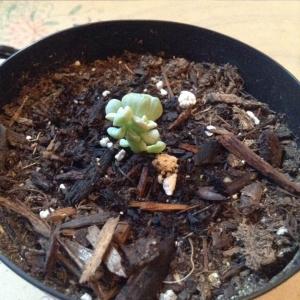



1
0



